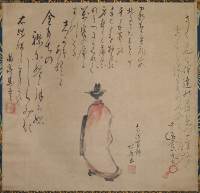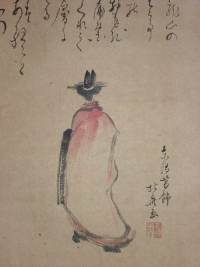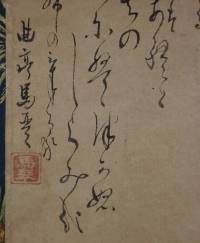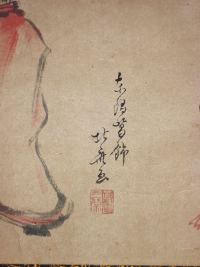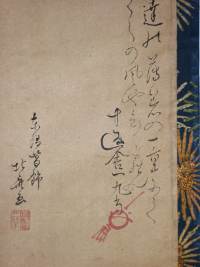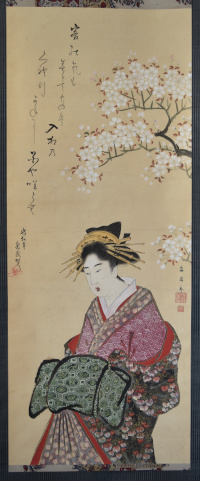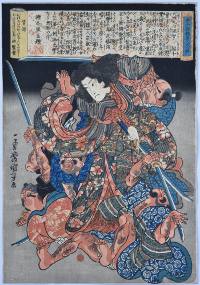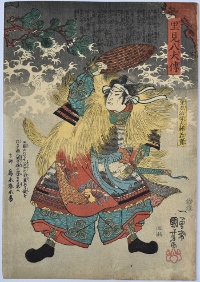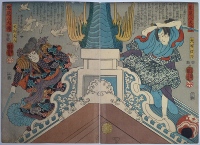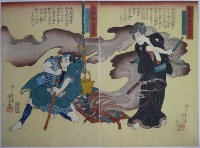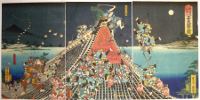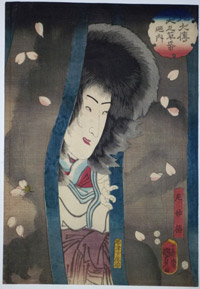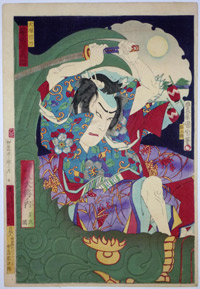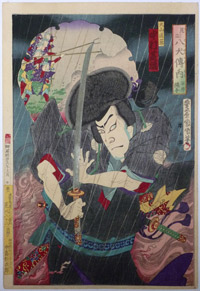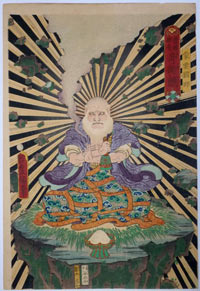Katsushika HOKUSAI (1760-1849); Kyokutei BAKIN (1767-1848); Jippensha IKKU (1765-1831)
Click here to view image full size.
An original painting by Hokusai showing the back view of a courtesan. Above are inscriptions by Bakin and Ikku, the two leading writers of the day. ( Bakin is famous for writing Chronicles of the Eight Dog Heroes of the Satomi Clan of Nanso and Ikku for writing the most humorous book in the Japanese language: Shank’s Mare Journey on the Tokaido.) This painting was originally sold at the Tokyo Bijutsu Club, December 3rd, 1928. It is illustrated in Katsushika Hokusai Paintings, Mainich Shimbun, 1975. It is signed Toyo Katsushika Hokusai ga, “Painted by Katsushika Hokusai of Orient” and the seal, Katsushika Hokusai, is the same seal as that used on the pair of hand scrolls, Day and Night, in the Museum of Fine Arts, Boston. Colour and sumi on paper, 11.12 x 11.5 in; 28.2 x 29.2 cms. An intriguing old mount and sold with original sales slip from 1928 and a copy of the 1975 catalogue.
The inscriptions translate as:
I went out dressed up very lightly just to show off for the sake of cherry blossom viewing party.
However, I ended up catching a cold and all my efforts to enjoy the cherry blossoms went for nothing.
Jippensha Ikku
Yoshiwara is located in the north of Mount Kinryu, and it is a very grassy place.
Here I live inside the fence of Miuraya,
I am worshiped by so many guests.
Even though I devote myself completely to seek popularity every day,
I am a louse whose heart cannot be stolen by money alone.
This is my mettle as a courtesan.
Kyokutei Bakin
Status: Sold
KYOJINSAI (Fl. c 1789-1801)
Click here to view image full size.
A large and fine original painting by an artist whom I am unable to find in the literature; possibly a pseudonym. Shows a high-ranking courtesan wearing a sumptuous kimono under cherry blossom. Full colour on paper, 49.25 x 20 in; 125 x 51 cms. The calligraphy above is by Kan’watei Onitake, best known as the author of a series of yomihon entitled Katakiuchi kidan Jiraiya setsuwa , “The Tale of the Gallant Jiraiya,” also known as the Jiraiya monogatari published in 11 volumes from 1806-7. The protagonist was a thief-come-wizard who is usually depicted astride a giant toad. Onitake was a pupil of Tani Buncho, Kyokutei Bakin and Santo Kyoden. It translates as a courtesan musing on the fact that customers’ attention in the spring turns to buying many things and, as the sun sets, will there be many clients in the Yoshiwara gathering as thickly as the cherry blossom. Signed Kan’watei Onitake san with a kakihan of an octopus. On the right the signature and seal of Kyojinsai. On the lid of the box is an inscription reading Kansei-ki Kyojinsai-hitsu oka no tayu sugata gasan, “A Kansai period inscribed painting of a high-class courtesan under cherry blossoms brushed by Kyojinsai.” And a repeat of the Onitake inscription. On the inside of lid: Showa shinyu Yayoi chukan, “Mid-March of the metal rooster [Showa 56/1981].” Appraised by Kimura Suetsuke ((a dealer and Ukiyo-e expert). Very good condition.
Status: Available
Utagawa KUNIYOSHI (1797-1861)
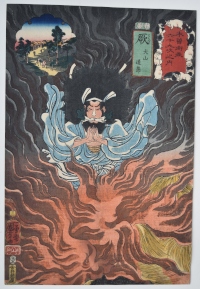
Click here to view image full size.
Inuyama Dosetsu, one of the eight dog heroes, enveloped in a conflagration. The heroes represent a Confucian ideal or Buddhist regulation and meet various adversaries in the epic Nanso satomi hakkenden, “Biography of the Eight Dogs” written by Takizawa Bakin between 1814 and 1842. Dosetsu is gifted with magic fire and is seen here with pine sprigs wrapped in paper clenched between his teeth. The subject represents Warabi Station (seen top left) from a set Kisokaido rokujuku tsugi, “Sixty-nine Stations along the Kisokaido.” In fact, a pun on the word warabi which can also mean “straw fire.” The bales can be seen bottom right. Published by Izutsuya Shokichi 1852. The best design from the set.
ga.
Fine impression and colour. Lightly backed and very slight vertical fold, otherwise very good condition. Signed Ichiyusai Kuniyoshi
Status: Available
Utagawa KUNISADA II (1823-1880)
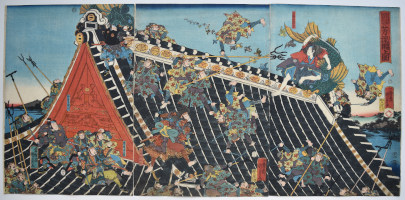
Click here to view image full size.
A triptych showing the fight on the roof of the Horyukaku Tower of Koga Castle beside the Tone River. A popular scene from the complex novel Nanso Satomi Hakkenden, “The Diary of Eight Dogs” by Takizawa Bakin (1767-1848). The macabre tale revolves around the eight offspring of a supernatural marriage between a princess and her father’s dog and their commitment to restore the fortunes of the samurai house of Satomi. Shows Inuzuka Shino Moritaka defending himself against the chief of police Inukai Kempachi Nobumichi. Published by Tsutaya Kichizo 1854.
Very good impression, colour and condition. Signed Ichijusai and Baichoro Kunisada ga.
Status: Available
Utagawa KUNIYOSHI (1797-1861)
Click here to view image full size.
Inuzaka Keno Tanetomo struggling with four adversaries from Kyokutei-o seicho Hakkenshi zui-ichi, “The One and Only Eight Dog History of Old Kyokutei [Bakin], Best of Refined Authors.” The set of eight prints form diptychs and are based on Bakin’s (1767-1848) famous novel Satomi Hakkenden, “Eight Dogs of the Satomi Clan.” Robinson S5.7.
Very good impression, colour and condition. Signed Ichiyusai Kuniyoshi ga.
Status: Sold
Utagawa KUNIYOSHI (1798-1861)
Click here to view image full size.
Satomi Jibu-no-taifu Yoshizane, a daimyo in control of Takita Castle from Satomi Hakkenden, the eight heroes of Bakin’s novel Hakkenden. Published by Mikawa-ya Tetsugoro, c 1849-51. See the Kunichika triptych of the same subject on this current selection.
Very good impression, colour and condition. Signed Ichiryusai Kuniyoshi ga.
Status: Sold
Utagawa KUNIYOSHI (1797-1861)
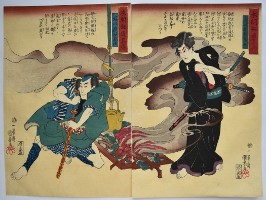
Click here to view image full size.
A complete diptych showing Inuyama Dosetsu Tadatomo with smoke curling around him and his hand on one of his swords facing Inugawa Sosuke Yoshito on one knee grasping his sword beside a wood fire from which the billowing smoke is emanating. Two of the heroes from Kyokutei Bakin’s famous book, Nanso Satomi hakkenden, “The Chronicles of the Eight Dog Heroes of the Satomi Clan of Nanso.” From a set of prints Kendo ryaku den “Abridged Stories of Our Country’s Swordsmamship.” Published by Kadzusa-ya Iwazo, c. 1845-6. The complete diptych is rare. Robinson S37.9.7.
Very fine impression, colour and condition. Signed Ichiyusai Kuniyoshi ga.
Status: Sold
Utagawa KUNIYOSHI (1797-1861)
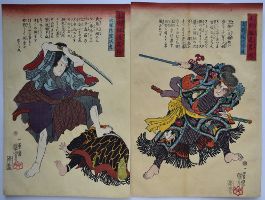
Click here to view image full size.
A complete diptych showing Inukai Kempachi wielding an iron truncheon against Inudzuka Shino who stands, sword drawn, with one foot on a fallen follower of Kempachi during the fight on the Horyukaku roof of Koga Castle. A well-known episode from Kyokutei Bakin’s famous book, Nanso Satomi hakkenden, “The Chronicles of the Eight Dog Heroes of the Satomi Clan of Nanso.” From a set of prints Kendo ryaku den “Abridged Stories of Our Country’s Swordsmamship.” Published by Kadzusa-ya Iwazo, c. 1845-6. Robinson S37.6.5. The complete diptych is rare.
Very fine impression, colour and condition. Signed Ichiyusai Kuniyoshi ga.
Status: Sold
Utagawa KUNISADA (1786-1865)
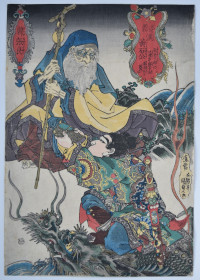
Click here to view image full size.
Kan Zhang Liang (below) and Huang Shigong from the set Kan-So gundan, “Battle Tales of the Han and Chu.” The success of the Chinese warrior tales retold by Takizawa Bakin (1767-1848) in his novel “The Water Margin: New Illustrated Edition” published in 1805 resulted in the commissioning of Kuniyoshi to produce his famous series based on the heroes of the “Water Margin” in the late 1820s. Likewise for this set by Kunisada from around the same date. The story relates how Zhang Liang was walking near the Yishui Bridge one day when he met an old man who threw his shoe from the bridge and ordered Zhang Liang to return it and place it on his foot. Without thanking him the old man walked off but with the instruction to meet him five days later. Zhang Liang duly returned at dawn five days later to find the old man already there. Annoyed, the old man reiterates his command but with the same result. The third time Zhang Liang arrives at midnight so impressing the old man with his punctuality, fortitude and humility that he presents him with a book the knowledge from which will bring peace and prosperity to the empire during troubled times. He also tells him to meet again in thirteen years when he will be the yellow rock at the foot of Mount Gucheng. The old man was Huang Shigong. Zhang Liang visits after thirteen years, finds the rock, builds a shrine and is buried with it. Kunisada’s design shows the moment that the shoe is presented back to Huang Shigong. Published by Eijudo c 1827 (although this impression does not have publisher’s mark). The set was reissued by Joshuya Juzo.
Very fine impression. Fine colour and condition. Signed Oju Gototei Kunisada ga.
Status: Sold
Utagawa KUNIYOSHI (1798-1861)
Click here to view image full size.
A complete diptych showing Inuzuka Shino and Inukai Kempachi on the Horyukaku roof from Satomi Hakkenden, the eight heroes of Bakin’s novel Hakkenden. Published by Mikawa-ya Tetsugoro, c 1849-51. See the Kunichika triptych of the same subject on this current selection. Rare complete.
Very good impression, colour and condition. Signed Ichiryusai Kuniyoshi ga.
Status: Sold
Utagawa KUNIYOSHI (1798-1861)
Click here to view image full size.
An oban diptych showing the two heroes, Inuyama Dosetsu Tadatomo ( seated ) and Inukawa Sosuke Yoshito. Chapter 22 from Bakin’s famous book of the Eight Dog Warriors. From a yellow-ground set: Honcho kendo ryaku den, “Abridged Stories of Our Country’s Swordsmanship.” Published by Kadzusa-ya Iwazo, c 1845-6. Robinson S37.7 & 9. Rare as the design is seldom found complete.
Very fine impression, fine colour and condition. Signed Ichiyusai Kuniyoshi ga.
Status: Sold
Ichiosai KUNICHIKA (1835-1900)
Click here to view image full size.
A triptych showing Inuzuka Shino at bay on the Horyukaku roof against Inukai Gempachi and his men. A famous episode from the Hakkenden written by Takizawa Bakin ( 1767 – 1848 ): Nanso Satomi Hakkenden no uchi Horyukaku no zu. The Daimyo, the Lord of Satomi, ordered Kenpachi to kill Shino – a strong man and great fighter who had killed some twenty retainers of the Lord. The pair fought on the roof only to fall into a boat on the river which broke loose and floated out to sea. The pair were discovered unconscious. Another, earlier triptych was designed by Kuniyoshi c 1836. Published c 1860 by Izutsuya.
Very fine impression, colour and condition. Signed Ichiosai Kunichika ga.
Status: Sold
Utagawa KUNISADA II (1823-1880)
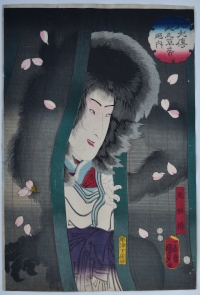
Click here to view image full size.
The actor Segawa Kikunojo V as the Cat Witch Ama Myochin from the set Hakkenden inu no soshi no uchi , “Stories of the Eight Dog Heroes.” Published by Tsutaya Kichizo, 1852. The extremely lengthy novel by Kyokutei Bakin took 30 years to complete and was turned into a very successful play which was premiered at the Ichimura-za Theatre, 1/1852. The convoluted story tells of the supernatural offspring from the coupling of Princess Fuse and her father’s dog Yatsufusa. They are later reborn to normal mothers and the plot revolves around their gradual discovery of each other. Shows the cat’s human form appearing through a bamboo curtain while her true self, with claws and hairy arms, can be seen silhouetted behind the curtain. She murders the father of the dog hero Inamura Kakutaro and then assumes his likeness. The best design from a fine set.
Very fine impression with burnishing and blind-printing. (The finest impression I have seen.) Fine colour. Small binding holes, otherwise fine condition. Full size. Signed Ichiyosai Kunisada ga.
Status: Sold
Utagawa KUNISADA II (1823-1880)
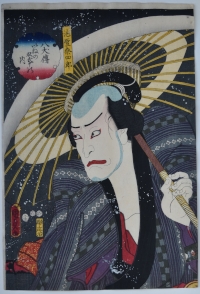
Click here to view image full size.
The actor Nakamura Tsuruzo I as Awayuki Nashito, a vassal of the daimyo Takeda Nobumasa, from the set Hakkenden inu no soshi no uchi , “Stories of the Eight Dog Heroes.” Published by Tsutaya Kichizo, 1852. The extremely lengthy novel by Kyokutei Bakin took 30 years to complete and was turned into a very successful play which was premiered at the Ichimura-za Theatre, 1/1852. The convoluted story tells of the supernatural offspring from the coupling of Princess Fuse and her father’s dog Yatsufusa. They are later reborn to normal mothers and the plot revolves around their gradual discovery of each other. A fine set.
Very fine impression with burnishing and extensive splashed gofun simulating snow. Later printings omit the gofun and have flakes cut into the block. Fine colour. Small binding holes, otherwise fine condition. Full size. Signed Kunisada ga.
Status: Sold
Utagawa KUNISADA II (1823-1880)
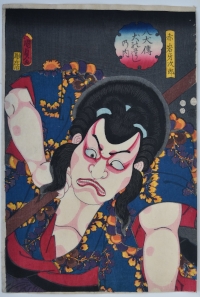
Click here to view image full size.
The Actor Bando Mitsuemon I as Akaiwa Gajiro from the set Hakkenden inu no soshi no uchi , “Stories of the Eight Dog Heroes.” Published by Tsutaya Kichizo, 1852. The extremely lengthy novel by Kyokutei Bakin took 30 years to complete and was turned into a very successful play which was premiered at the Ichimura-za Theatre, 1/1852. The convoluted story tells of the supernatural offspring from the coupling of Princess Fuse and her father’s dog Yatsufusa. They are later reborn to normal mothers and the plot revolves around their gradual discovery of each other. A fine set.
Very fine impression with extensive burnishing. Later printings omit the burnishing on the costume and replace it with bokashi. Fine colour. Small binding holes, otherwise fine condition. Full size. Signed Kunisada ga.
Status: Sold
Utagawa KUNISADA II (1823-1880)
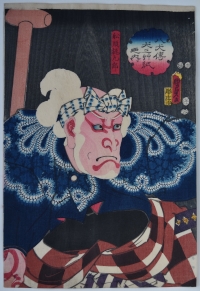
Click here to view image full size.
The actor Kataoka Ichizo I as the boatman Kajikuro from the set Hakkenden inu no soshi no uchi , “Stories of the Eight Dog Heroes.” Published by Tsutaya Kichizo, 1852. The extremely lengthy novel by Kyokutei Bakin took 30 years to complete and was turned into a very successful play which was premiered at the Ichimura-za Theatre, 1/1852. The convoluted story tells of the supernatural offspring from the coupling of Princess Fuse and her father’s dog Yatsufusa. They are later reborn to normal mothers and the plot revolves around their gradual discovery of each other. A fine set.
Extremely fine impression. Fine colour. Small binding holes, otherwise fine condition. Full size. Signed Kunisada ga.
Status: Sold
Utagawa KUNISADA II (1823-1880)
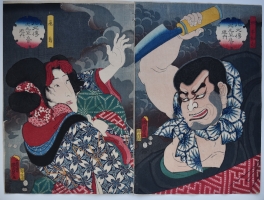
Click here to view image full size.
The complete diptych showing on the right the actor Arashi Otohachi III as the evil priest Bungyu attacking Asuka played by Fujikawa Kayu III from the set Hakkenden inu no soshi no uchi , “Stories of the Eight Dog Heroes.” Published by Tsutaya Kichizo, 1852. The extremely lengthy novel by Kyokutei Bakin took 30 years to complete and was turned into a very successful play which was premiered at the Ichimura-za Theatre, 1/1852. The convoluted story tells of the supernatural offspring from the coupling of Princess Fuse and her father’s dog Yatsufusa. They are later reborn to normal mothers and the plot revolves around their gradual discovery of each other. A fine set.
Extremely fine impressions. Fine colour. Small binding holes, otherwise fine condition. Full size. Signed Kunisada ga and Ichiyosai Kunisada ga.
Status: Sold
Utagawa KUNISADA (1786-1865)
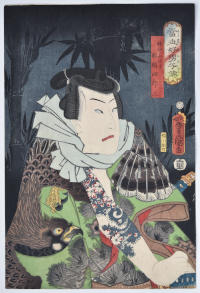
Click here to view image full size.
A bust portrait of the actor Bando Hikosaburo V as Samezaya Shiroza compared to Lin Chong (from the famed Chinese novel Shui Hu Zhuan, “Outlaws of the Marsh”) retold by Takizawa Bakin (1767-1848) in his novel “The Water Margin: New Illustrated Edition” published in 1805. There are three groups of three prints with background motifs of Pine, Bamboo (as here) and Plum, being the symbols of longevity. He is shown with a heavily tattooed arm of plum blossom and his coat is decorated with a design of a large eagle enveloping his shoulders. Published by Hayashiya Shogoro, 1859.
Very fine impression. Fine colour and condition. Signed Ni Konomi Toyokuni ga.
Status: Sold
Tsukioka YOSHITOSHI (1839-1892)
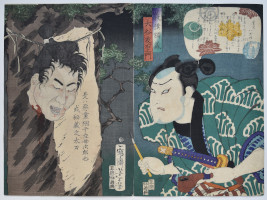
Click here to view image full size.
A diptych showing the actor Otani Tomoemon V as the loyal servant Gakuzo (aka Inukawa Sosuke Yoshito, one of the eight Dog half-brothers), brush in hand, having just hung the decapitated head of the evil Aboshi on a tree and written beside it: Kore ha akuto Aboshi Samojiro nari. Aruiwa hizo tachi, “This is the villain Aboshi Samojiro… He [stole] a treasured sword [Murasame – the treasured sword of the Ashikaga family].” Shows a scene from an episode in Part III, volume 5 of the Satomi Hakkenden no uchi, “Tales of the Eight Dogs of the Satomi Clan.” The macabre tale, written by Kyokutei Bakin (1767-1848) in 98 chapters and 106 booklets, revolves around the eight offspring of a supernatural marriage between a princess and her father’s dog and their commitment to restore the fortunes of the samurai house of Satomi. Published by Tamaya Sosuke 1868. Very rare: Keyes in his dissertation on Yoshitoshi lists just the right sheet from an oban series, presumably the print in the Philadelphia Museum of Art, ART568220, and another impression of just the right sheet is owned by Tateyama City in Chiba Prefecture.
Very good impression, colour and condition. Signed Kaisai Yoshitoshi hitsu. (Keyes attributes this print to Yoshitoshi as he hadn’t seen the left sheet.)
Status: Sold
Utagawa KUNISADA II (1823-1880)
Click here to view image full size.
The cat witch Ama Myochin. The best design from the set Hakkenden inu no soshi no uchi, biographies of the Eight Dog heroes. She peeps between two bamboo curtains, the silhouette of her true self – large hairy body and huge claws – being revealed through the curtains. Cherry blossom floats down. Published 1852 by Tsutaya Kichizo. The Hakkenden, Bakin’s famous novel, was a popular source for ukiyo-e artists.
Very good impression and colour. Slightly trimmed round. Signed Ichiyosai Kunisada ga.
Status: Sold
Toyohara KUNICHIKA (1835-1900)
Click here to view image full size.
Suketakaya Takasuke IV as Inuzuka Shino on the roof of the pavilion Horyukaku fighting Kenpachi. A fine set based on Bakin’s Hakkenden, entitled “A Parody of the Hakkenden” published by Fukuda Kumajiro, 1883. A rare series that shows, even at this late date, there are flashes of brilliance.
Very fine impression of the first de-luxe edition with silver and beautiful bokashi. Fine colour and condition. Full size. Signed Yasohachi Kunichika hitsu.
Status: Sold
Toyohara KUNICHIKA (1835-1900)
Click here to view image full size.
Nakamura Shikan II as Inuyama Dosetsu battling with Inukai Kenpachi. A fine set based on Bakin’s Hakkenden entitled “A Parody of the Hakkenden” published by Fukuda Kumajiro, 1883. A rare series that shows, even at this late date, there are flashes of brilliance.
Very fine impression of the first de-luxe edition with extensive burnishing and silver. Fine colour and condition. Full size. Signed Yasohachi Kunichika hitsu.
Status: Sold
Utagawa KUNISADA (1786-1865)
Click here to view image full size.
The best design from Toyokuni kigo kijutsu kurabe, “A Contest of Magic Scenes by Toyokuni.” Shows the actor Ichikawa Kodanji IV as Mo’un Kokushi. The story is based on the Takizawa Bakin and Hokusai Chinsetsu yumiharizuki. The magician is seated on a rocky promontory with exploding rocks emanating from behind his head. A stunning design. Published by Hirayano Shinzo, 1863.
Superb impression, colour and condition. The deluxe first edition on thick hosho and every refinement of printing using the finest pigments, burnishing, mica and gofun. Extra paper at left and top. Signed The 79 year old Toyokuni hitsu.
Status: Sold
Artists
( A to Z )
Kyogado ASHIKUNI ( Fl. c. 1807 – 1818 )
Gigado ASHIYUKI ( Fl. c. 1814 – 1833 )
Ki BAITEI ( 1734 – 1810 )
Takizawa BAKIN ( 1767 – 1848 )
Ono BAKUFU ( 1888 – 1976 )
Georges BIGOT ( 1860 – 1927 )
Kawamura BUMPO ( 1779 – 1821 )
Ippitsusai BUNCHO ( Fl. c. 1765 – 1792 )
Toyohara CHIKANOBU ( 1838 – 1912 )
Kishi CHIKUDO ( 1826 – 1897 )
Tsubaki CHINZAN ( 1801 – 1854 )
Eishosai CHOKI ( Fl. c. 1756 – 1808 ). See also SHIKO
Rekisentei EIRI ( Fl. c. 1790 – 1800 )
Keisai EISEN ( 1790 – 1848 )
Hosoda EISHI ( 1756 – 1829 )
Hosoda EISHO ( Fl. c. 1780 – 1800 )
Ichirakutei EISUI ( Fl. c. 1790 – 1823 )
Kikugawa EIZAN ( 1787 – 1867 )
Hirano HAKUHO ( 1879 – 1957 )
Elizabeth KEITH ( 1887 – 1956 )
Imao KEINEN ( 1845 – 1924 )
Yashima GAKUTEI ( 1786 – 1868 )
Ogata GEKKO ( 1859 – 1920 )
Adachi GINKO ( Fl. c. 1847 – 1897 )
Matsumura GOSHUN ( 1752 – 1811 )
GYOSAI. See Kawanabe KYOSAI
Hirano HAKUHO ( 1879 – 1957 )
Suzuki HARUNOBU ( 1724 – 1770 )
Kawase HASUI ( 1883 – 1957 )
Kitagawa HIDEMARO ( Fl. c. early 19th century )
Kinoshita HIRONOBU ( Fl. c. 1851 – 1870 )
Gosotei HIROSADA ( Fl. c. 1847 – 1863 )
Ichiryusai HIROSHIGE ( 1797 – 1858 )
Ichiryusai HIROSHIGE II ( 1826 – 1869 )
Ando HIROSHIGE III ( 1843 – 1894 )
Nakamura HOCHU ( Fl. c. late 18th to early 19th century )
Sakai HOITSU ( 1761 – 1828 )
Totoya HOKKEI ( 1780 – 1850 )
Teisai HOKUBA ( 1771 – 1844 )
Shunkosai HOKUEI (Active 1824-1837)
Katsushika HOKUGA ( Fl. c. 1830 )
Shotei HOKUJU ( Fl. c. 1789 – 1818 )
Katsushika HOKUSAI ( 1760 – 1849 ). Also used numerous other names such as: SORI, SHUNRO, SHINSAI
Shokosai HOKUSHU ( Fl. c. 1808 – 1832 )
KEISAI. See Kitao MASAYOSHI
Suzuki KIITSU ( 1796 – 1858 )
Kitagawa KIKUMARO ( Fl. c. ? – 1830 ). See TSUKIMARO
Kobayashi KIYOCHIKA ( 1847 – 1915 )
Torii KIYOHIRO ( Fl. c. 1737 – 1771 )
Torii KIYOMASA ( Fl. c. 1700 – 1722 )
KIYOMINE. See Torii KIYOMITSU II
Torii KIYOMITSU ( 1735 – 1785 )
Torii KIYOMITSU II ( 1787 – 1868 ). See KIYOMINE
Torii KIYONAGA ( 1752 – 1815 )
Torii KIYONOBU ( 1664 – 1729 )
Torii KIYONOBU II ( 1706 – 1763 )
Torii KIYOTSUNE ( Fl. c. 1757 – 1779 )
Isoda KORYUSAI ( Fl. c. 1767 – 1788 )
Ohara KOSON ( 1877 – 1945 ). See SHOSON
Torii KOTONDO ( 1900 – 1976 )
Toyohara KUNICHIKA ( 1835 – 1900 )
Utagawa KUNIHIRO ( Fl. c. 1815 – 1843 )
Ichiunsai KUNIHISA ( 1832 – 1891 )
Utagawa KUNINAO ( 1793 – 1854 )
Utagawa KUNISADA ( 1786 – 1865 )
Utagawa KUNISADA II ( 1823 – 1880 )
Utagawa KUNISATO ( ? – 1858 )
Utagawa KUNITERU ( 1808 – 1876 )
KUNITERU. See Utagawa SADASHIGE
Utagawa KUNITERU II ( 1829 – 1874 )
Utagawa KUNIYASU ( 1794 – 1832 )
Ichiyusai KUNIYOSHI ( 1797 – 1861 )
Santo KYODEN. See Kitao MASANOBU
Kawanabe KYOSAI ( 1831 – 1889 ). See GYOSAI
Okumura MASANOBU ( 1686 – 1764 )
KitaoMASANOBU ( 1761 – 1816 ). See Santo KYODEN
Kitao MASAYOSHI ( 1764 – 1824 ). See KEISAI
Oishi MATORA ( 1794 – 1833 )
Hishikawa MORONOBU ( Fl. c. 1618 – 1694 )
Nishimura NANTEI ( 1775 – 1834 )
Utagawa NOBUKATSU ( Fl. c. 1830 – 1844 )
Watanabe NOBUKAZU ( Fl. c. late 19th century )
Hishikawa RYUKOKU ( Fl. c. 1808 – 1816 )
Jokei RYUKOSAI ( Fl. 1772 – 1816 )
Gokitei SADAFUSA ( Fl. c. 1825 – 1850 )
Hasegawa SADAHARU ( Fl. c. 1830 – 1844 )
Gokotei SADAKAGE ( Fl. c. 1818 – 1844 )
Utagawa SADAHIDE ( 1807 – 1873 )
Hasegawa SADANOBU ( 1809 – 1879 )
Utagawa SADASHIGE ( Fl. c. mid 19th century ). See KUNITERU
Gofutei SADATORA ( Fl. c. 1825 )
Yamaguchi SHIGEHARU ( 1803 – 1853 )
Kitao SHIGEMASA ( 1739 – 1820 )
Nishimura SHIGENAGA ( 1697 ? – 1756 )
Nishimura SHIGENOBU ( Fl. c. 1724 – 1735 )
SHIKO. See Eishosai CHOKI
Ryuryukyo SHINSAI ( 1764 – 1820 )
Ito SHINSUI ( 1898 – 1972 )
Kojima SHOGETSU ( Fl. c. 1880 – 1890 )
SHOSON. See Ohara KOSON
Takahashi SHOTEI ( 1871 – 1945 )
Yamamoto SHOUN ( 1870 – 1965 )
Yamakawa SHUHO ( 1898 – 1944 )
Katsukawa SHUNCHO ( Fl. c. 1780 – 1795 )
Takehara SHUNCHOSAI ( Fl. c. 1772 – 1801 )
Katsukawa SHUN’EI ( 1762 – 1819 )
Katsukawa SHUNKO ( 1743 – 1812 )
Hishikawa SHUNKYO ( Fl. c. early 19th century )
Kubo SHUNMAN ( 1757 – 1820 )
Katsukawa SHUNSEN ( Fl. c. 1762 – 1830 )
Natori SHUNSEN ( 1886 – 1960 )
Gatoken SHUNSHI ( Fl. c. 1820 – 1828 )
Katsukawa SHUNSHO ( 1726 – 1792 )
Katsukawa SHUNTEI ( 1770 – 1820 )
Katsukawa SHUNZAN ( Fl. c. 1782 – 1798 )
Yamaguchi SOKEN ( 1759 – 1834 )
Ikeno TAIGA ( 1723 – 1776 )
Katsukawa TERUSHIGE ( Fl. c. 1715 – 1725 )
Mori TETSUZAN (1775-1841)
Migita TOSHIHIDE ( 1863 – 1925 )
Mizuno TOSHIKATA ( 1866 – 1908 )
Okumura TOSHINOBU ( Fl. c. 1717 – 1750 )
Utagawa TOYOHARU ( 1735 – 1814 )
Utagawa TOYOHIRO ( 1773 – 1828 )
Utagawa TOYOKUNI ( 1769 – 1825 )
Utagawa TOYOKUNI II ( 1777 – 1835 ). See TOYOSHIGE
Yamamura TOYONARI ( 1885 – 1942 )
Ishikawa TOYONOBU ( 1711 – 1785 )
TOYOSHIGE. See Utagawa TOYOKUNI II
TSUKIMARO. See Kitagawa KIKUMARO
Kitano TSUNETOMI ( 1880 – 1947 )
Toyokawa UMEKUNI ( Fl. c. 1816 – 1826 )
Kitagawa UTAMARO ( 1753 – 1806 )
Kitagawa UTAMARO II ( ? – 1831 )
Inoue YASUJI ( 1864 – 1889 )
Hiroshi YOSHIDA ( 1876 – 1950 )
Ipposai YOSHIFUJI ( 1828 – 1887 )
Utagawa YOSHIIKU ( 1833 – 1904 )
Utagawa YOSHIKATA ( Fl. c. 1841 – 1864 )
Utagawa YOSHIKAZU ( Fl. c. 1850 – 1870 )
Toyokawa YOSHIKUNI ( Fl. c. 1803 – 1840 )
Utagawa YOSHIMUNE ( 1817 – 1880 )
Ichiyosai YOSHITAKI ( 1841 – 1899 )
Utagawa YOSHITORA ( Fl. c. 1850 – 1880 )
Taiso YOSHITOSHI ( 1839 – 1892 )
Utagawa YOSHITSURU ( Fl. c. 1840 – 1850 )
Ichieisai YOSHITSUYA ( 1822 – 1866 )
Mori YOSHIYUKI ( 1835 – 1879 )
Shibata ZESHIN ( 1807 – 1891 )
